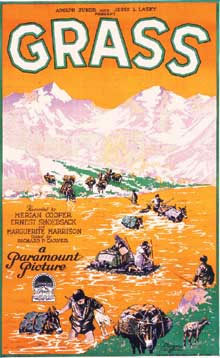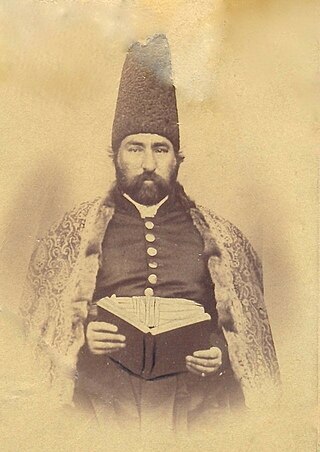Related Research Articles

Grass: A Nation's Battle for Life is a 1925 documentary film that follows a branch of the Bakhtiari tribe of Lurs in Persia as they and their herds make their seasonal journey to better pastures. It is considered one of the earliest ethnographic documentary films. In 1997, Grass was selected for preservation in the United States National Film Registry by the Library of Congress as being "culturally, historically, or aesthetically significant."

The Uzbek Khanate, also known as the Abulkhair Khanate was a Shaybanid state preceding the Khanate of Bukhara. During the few years it existed, the Uzbek Khanate was the preeminent state in Central Asia, ruling over most of modern-day Uzbekistan, much of Kazakhstan and Turkmenistan, and parts of southern Russia. This is the first state of the Abulkhairids, a branch of the Shaybanids.
Ahmad Alaq was the Khan of Eastern Moghulistan from 1487 to 1504. He was the second son of Yunus Khan. His mother was Shah Begum, fourth daughter of Badakhshan prince Lali.
Dost Muhammad Khan was Khan of Aqsu in Moghulistan from 1462 until his death. He was the son of Esen Buqa II.

Yunus Khan, was Khan of Moghulistan from 1462 until his death in 1487. He is identified by many historians with Ḥājjī `Ali, of the contemporary Chinese records. He was the maternal grandfather of Babur, founder of the Mughal Empire.
Sultan Said Khan ruled the Yarkent Khanate from September 1514 to July 1533. He was born in the late 15th century in Moghulistan, and he was a direct descendant of the first Moghul Khan, Tughlugh Timur, who had founded the state of Moghulistan in 1348 and ruled until 1363. The Moghuls were turkicized Mongols who had converted to Islam.

Layla and Majnun, also spelled as Leili-o-Majnun or Laili-o-Majnoon, is a 1937 Iranian romance film produced in 1937 by Abdolhossein Sepanta by the East India Film Studios.

Ala-ud-Din Hasan Bahman Shah whose original name was Zafar Khan or Hasan Gangu, was the founder of the Bahmani Sultanate.
Mirza Muhammad Haidar Dughlat Beg was a Chagatai Turco-Mongol military general, governor of Kashmir, and a historian. He was a Mughal Dughlat prince who wrote in both Chaghatai and Persian languages. Haidar and Babur were cousins on their mother's side, through the line of Genghis Khan. Unlike Babur, Haidar considered himself more of an ethnic Mongol of Moghulistan.
Muhammad Haidar Mirza was the Dughlat amir of Kashgar from c. 1465 until 1480. He was the grandfather and namesake of the historian Muhammad Haidar Mirza (1499/1500-1551).
The Dughlat clan was a Mongol clan that served the Chagatai khans as hereditary vassal rulers of several cities in western Tarim Basin, in modern Xinjiang, from the 14th century until the 16th century. The most famous member of the clan, Mirza Muhammad Haidar, was a military adventurer, historian, and the ruler of Kashmir (1541–1551). His historical work, the Tarikh-i Rashidi, provides much of the information known about the family.
Bahman is the eleventh and penultimate month of the Solar Hijri calendar, the official calendar of Iran and Afghanistan. Bahman has thirty days. It begins in January and ends in February of the Gregorian calendar. The month is equivalent to Aquarius in the Zodiac.

The Province of Sira, also known as Carnatic-Balaghat, was a subah of the Mughal empire in South India that was established in 1687 by conquering emperor Aurangzeb and lasted until 1757. The province, which comprised the Carnatic region south of the Tungabhadra river, had its capital in the town of Sira. It was composed of seven parganas (districts): Basavapatna, Budihal, Sira, Penukonda, Dod-Ballapur, Hoskote and Kolar; in addition, Harpanahalli, Kondarpi, Anegundi, Bednur, Chitaldroog and Mysore were considered by the Mughals to be tributary states of the province.

Bahman Mirza was a Qajar prince, literary scholar, and writer who lived in Iran and later the Russian Empire. The fourth son of the former crown prince Abbas Mirza, his career in Iran was marked by several governorships, including the province of Azerbaijan (1841–1847).

The Yarkent Khanate, also known as the Yarkand Khanate and the Kashghar Khanate, was a Sunni Muslim Turkic state ruled by the Mongol descendants of Chagatai Khan. It was founded by Sultan Said Khan in 1514 as a western offshoot of Moghulistan, itself an eastern offshoot of the Chagatai Khanate. It was eventually conquered by the Dzungar Khanate in 1705.

Abbas Kiarostami: A Report is a 2013 documentary film about the Iranian filmmaker Abbas Kiarostami, produced and directed by Bahman Maghsoudlou. Out of the documentaries Maghsoudlou has made, this is the first of feature length.

Mohammad Taqi Mirza Hessam os-Saltaneh was a Persian Prince of the Qajar dynasty, son of Fath Ali Shah. He was Governor-General (beglerbegi) of Kermanshah and of Boroujerd.

The House of Bahmani, also Bahmani-Qajar is an aristocratic Iranian family belonging to one of the princely families of the Qajar dynasty, the ruling house that reigned Iran 1785–1925. The founder is Bahman Mirza Qajar (1810–1884), the younger brother of Mohammad Shah Qajar and formerly prince regent and governor of Azerbaijan 1841–1848.

Razor's Edge: The Legacy of Iranian Actresses is a 2016 documentary written and directed by Bahman Maghsoudlou. The film examines the Iranian film industry, starting in the 1930s and through the Iranian Revolution of 1979. The film features extensive interviews many with the actresses themselves, and clips from films.
References
- ↑ Maghsoudlou, Bahman (2009), Grass:Untold Stories